As summer approaches with its blistering heat, your early-blooming spring flowers can start to wilt under the temperatures and full sun conditions. With your border garden looking a little tired, you might be looking to switch out your daffodils and spring crocus with something a bit more tolerant of the heat and sunshine. Now is the time to break out your favorite heat-loving flowers like lantana and zinnias until the weather becomes cool again. Alternatively, you can plan for the autumn season as well by planting some long-blooming, cold hardy options like coneflowers.
Your summer border garden is a great opportunity to bring pollinators and beneficial insects into your yard to help your plants grow and protect them from harmful pests and diseases. As explained by PennState Extension, intentionally growing summer flowers that produce nectar and pollen for insects will help you reduce your need for insecticides and help your garden flourish. Plan out your summer border garden with a variety of these 15 colorful flowers, and watch how your landscape thanks you.
Milkweed

When planning your summer border garden design, we recommend putting milkweed (asclepias syriaca) near the top of your list. As told by Prairie Nursery, this fragrant flower is the only plant that monarch butterflies will lay their eggs on. By planting milkweed, you can help combat the declining population of these creatures and bring more life to your garden.
Bloom Season: Summer
USDA Growing Zone: 3 to 8
Growing Conditions: Full sun to partial shade
Soil Type: Well-draining
Size: 2 to 4 feet tall
Siberian iris
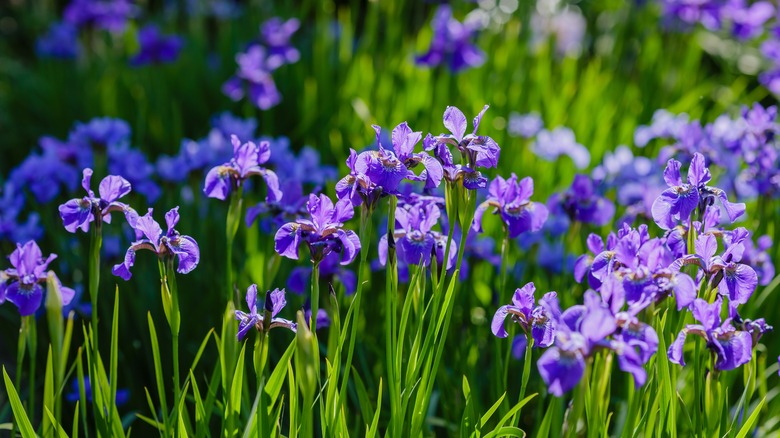
The Siberian iris (iris sibirica) is a fast-growing, water-loving herbaceous perennial that is best paired with other flowers such as daylilies and coneflowers, according to Monrovia. This species is one of the few flowers that bloom in true blue. It makes for a great contrast against warm-toned flowers with similar care requirements.
Bloom Season: Spring and summer
USDA Growing Zone: 4 to 9
Growing Conditions: Full sun
Soil Type: Rich and well-draining
Size: Up to 2 feet tall
English daisies

Cristina Ionescu/Shutterstock
English daisies (bellis perennis) bear a mixed reputation. While some love their cheery white and yellow appearance, others consider them an annoying weed. No matter where you stand on the issue, it’s true that these flowers enjoy warm summers and plenty of water, says Missouri Botanical Garden.
Bloom Season: Summer
USDA Growing Zone: 4 to 8
Growing Conditions: Full sun to partial shade
Soil Type: Rich and well-draining
Size: 3 to 6 inches tall and 3 to 9 inches wide
Begonia

Olga Vasilek/Shutterstock
In the late spring and summer months, begonias (begonia spp.) show off attractive, fragrant flowers that look great in summer border gardens. As mentioned by Clemson Cooperative Extension, the flowers in this genus vary in color, shape, and habit between cultivars. You’ll have many options to choose from when designing your landscape.
Bloom Season: Late spring and summer
USDA Growing Zone: 7 to 11, depending on the cultivar
Growing Conditions: Organic, moist, and well-draining
Soil Type: Partial shade to full sun
Size: Between 8 to 24 inches tall
Zinnias

vickyfatkhur/Shutterstock
Zinnias (zinnia spp.) are annuals that require warm weather, full sun, and regular watering in order to bloom. When they are cared for correctly, they can flower from the beginning of summer until the first frost, as per PennState Extension. They make a good addition to pollinator gardens beside milkweed and other nectar-rich flowers.
Bloom Season: Summer
USDA Growing Zone: 9 to 11
Growing Conditions: Full sun
Soil Type: Well-draining
Size: 6 inches to 3 feet tall
Coneflowers

Evannovostro/Shutterstock
Coneflowers (echinacea spp.) are known for their upright habit, sturdy stems, and deer resistance. If you regularly have problems with deer visiting your garden, flowers like this can help to protect your hard work. Clemson Cooperative Extension points out that although this genus is resistant to deer, it is not resistant to rabbits. You may need to take extra steps to protect your coneflowers’ foliage.
Bloom Season: Summer to fall
USDA Growing Zone: 3 to 9
Growing Conditions: Full sun to partial shade
Soil Type: Moist and well-draining
Size: 4 feet tall and 2 feet wide
Lavender
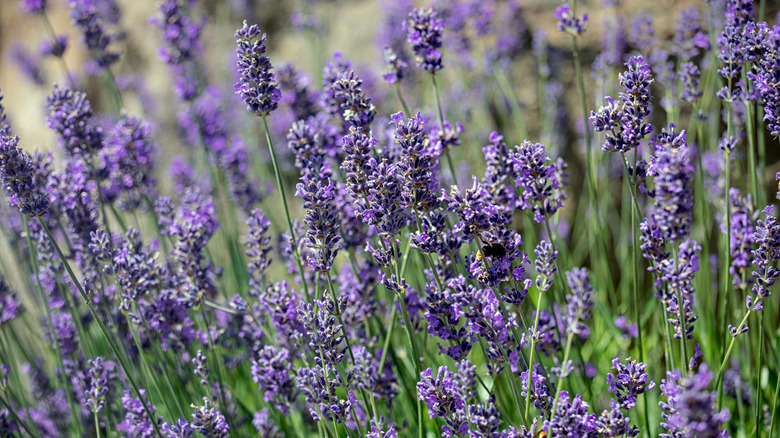
Chris Lawrence Travel/Shutterstock
Lavender plants (lavandula angustifolia) always make a happy addition to almost any type of garden. Their scented flowers and leaves may induce a deep sense of calm as you sit near your summer border garden. Missouri Botanical Garden suggests regular pruning to control the size of the plant. Keep your trimmings to use in sachets, potpourris, and teas.
Bloom Season: Summer
USDA Growing Zone: 5 to 8
Growing Conditions: Full sun
Soil Type: Well-draining
Size: 3 feet tall and 4 feet wide
Jasmine
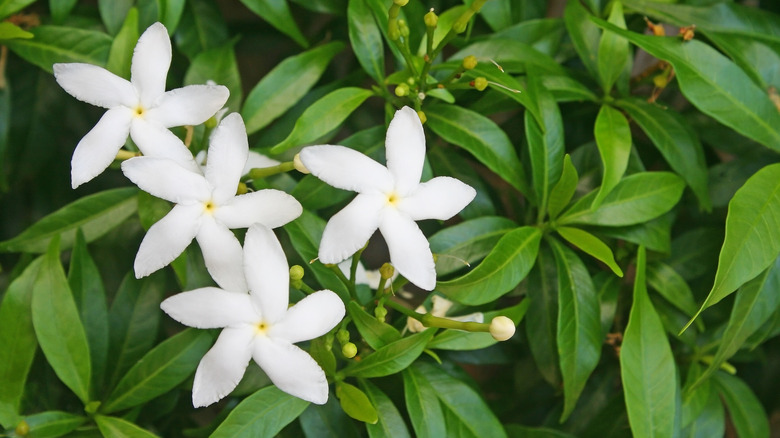
Amam ka/Shutterstock
Jasmine (jasminum officinale) is another scented flower that does well outdoors either pruned into a shrub or grown long on a trellis. The semi-vining shrub blooms from the beginning of summer into the fall with the right kind of care, explains Clemson Cooperative Extension. It needs plenty of sunlight and regular watering.
Bloom Season: Summer to fall
USDA Growing Zone: 7 to 10
Growing Conditions: Full sun to partial shade
Soil Type: Well-drained potting mix
Size: Up to 15 feet tall
Carnation

aniana/Shutterstock
Carnations (dianthus caryophyllus) are popularly grown because they are low-maintenance, and they come in a range of colors. Monrovia mentions that this species of dianthus looks best in the middle of summer border gardens, where they can be chosen to compliment or contrast the flowers that surround them.
Bloom Season: Spring and summer
USDA Growing Zone: 3 to 9
Growing Conditions: Full sun
Soil Type: Rich and well-draining
Size: 4 to 36 inches tall
Globe amaranth

Gita Sari/Shutterstock
Globe amaranth (gomphrena globosa) is an unusual flowering species native to the tropical regions of Panama, Guatemala, and other Central American countries, as told by University of Wisconsin-Madison. The blooms, which look similar to clover flowers, are of interest to butterflies that are attracted to their warm-toned bracts.
Bloom Season: Summer to fall
USDA Growing Zone: 9 to 11
Growing Conditions: Full sun
Soil Type: Moist and well-draining
Size: 2 feet tall and 1 foot wide
Primrose
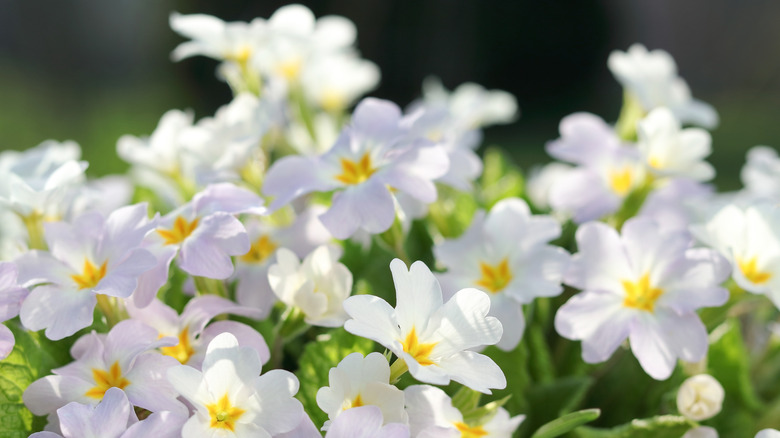
Mariia Romanyk/Shutterstock
Primrose (primula vulgaris) is grown for its dainty, fragrant flowers that come in shades of purple, white, cream, and yellow. These flowers cannot be grown in full sun, so they are best planted under tall plants and shrubs that can provide them with shade, as noted by North Carolina State Extension.
Bloom Season: Spring and summer
USDA Growing Zone: 4 to 8
Growing Conditions: Partial shade
Soil Type: Well-draining
Size: 3 inches to 6 feet tall and 4 to 8 feet wide
Hummingbird mint
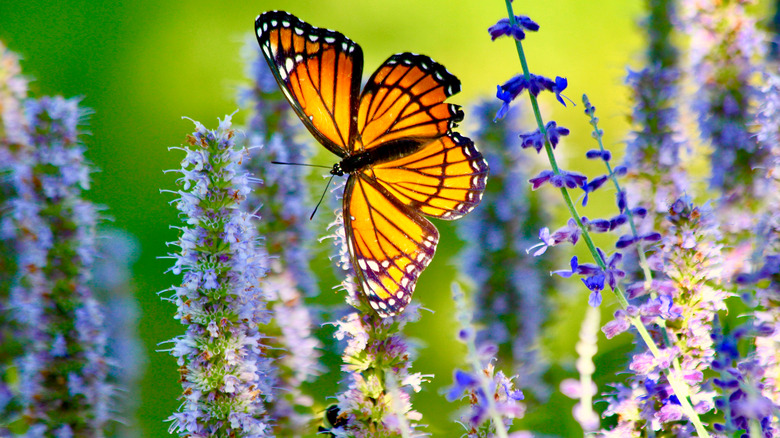
Molly Shannon/Shutterstock
Hummingbird mint (agastache spp.), which is also called ‘giant hyssop,’ is a flowering herbaceous perennial that produces fragrant, tasty leaves that can be used in teas. According to North Carolina State Extension, hummingbird mint gets its name from its long-blooming flowers that are appealing to pollinators like bees, butterflies, and hummingbirds.
Bloom Season: Summer
USDA Growing Zone: 5 to 10
Growing Conditions: Full sun
Soil Type: Well-draining loam or sand
Size: 1 to 3 feet tall and 1 to 2 feet wide
Yellow daylily

mcajan/Shutterstock
Yellow daylilies (hemerocallis lilioasphodelus) are a relatively easy-to-grow flower that is tolerant of a variety of soil types, says RHS. As indicated by the common name, these daylilies always bloom in yellow, and these flowers are typically less than 4 inches wide. Growing just as tall as the flower stems, sword-like green foliage surrounds the blooms for a lush look.
Bloom Season: Summer
USDA Growing Zone: 4 to 8
Growing Conditions: Full sun
Soil Type: Well-draining, moist, and fertile
Size: 1 to 3 feet tall and wide
Lantana
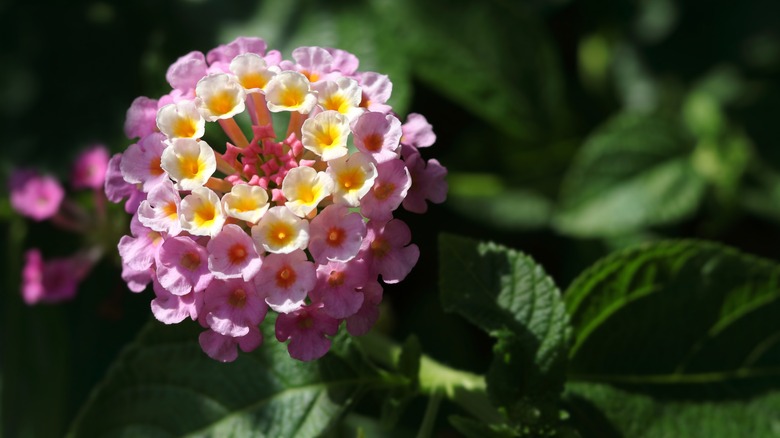
Mariia Romanyk/Shutterstock
The lantana plant (lantana camara) is a small shrub that needs full sun, well-draining soil, and limited watering, as taught by the University of Wisconsin-Madison. Depending on the USDA zone you live in, you may be able to treat this flowering shrub as a perennial, but in most states, it is an annual.
Bloom Season: Spring
USDA Growing Zone: 8 to 10
Growing Conditions: Full sun
Soil Type: Well-draining
Size: Up to 6 feet tall
Ornamental onion

Alexandr Golovkin/Shutterstock
Per Missouri Botanical Garden, ornamental onions (allium caeruleum) can be grown in a sunny and dry area of your garden. They produce bulbous flowering clusters that look like fluffy blue orbs when they are in full bloom. The stems of ornamental onions smell similar to cultivated onions (allium cepa) when crushed.
Bloom Season: Summer
USDA Growing Zone: 4 to 8
Growing Conditions: Full sun
Soil Type: Well-draining, rich, and sandy
Size: 1 to 2 feet tall and 6 inches to 1 foot wide




